Contract Law: Negligence and Exclusion Clauses
VerifiedAdded on 2020/05/11
|15
|2499
|339
AI Summary
This assignment presents a detailed case study examining the application of contract law principles to a scenario involving a damaged gown and a drycleaner's negligence. Students are tasked with analyzing the facts, identifying relevant rules (including Curtis v Chemical Cleaning and Dyeing Co), applying these rules to the case, and ultimately concluding whether Jane can successfully claim damages for her damaged gown. The analysis must consider the role of exclusion clauses and potential misrepresentation in the context of the contract.
Contribute Materials
Your contribution can guide someone’s learning journey. Share your
documents today.

Secure Best Marks with AI Grader
Need help grading? Try our AI Grader for instant feedback on your assignments.
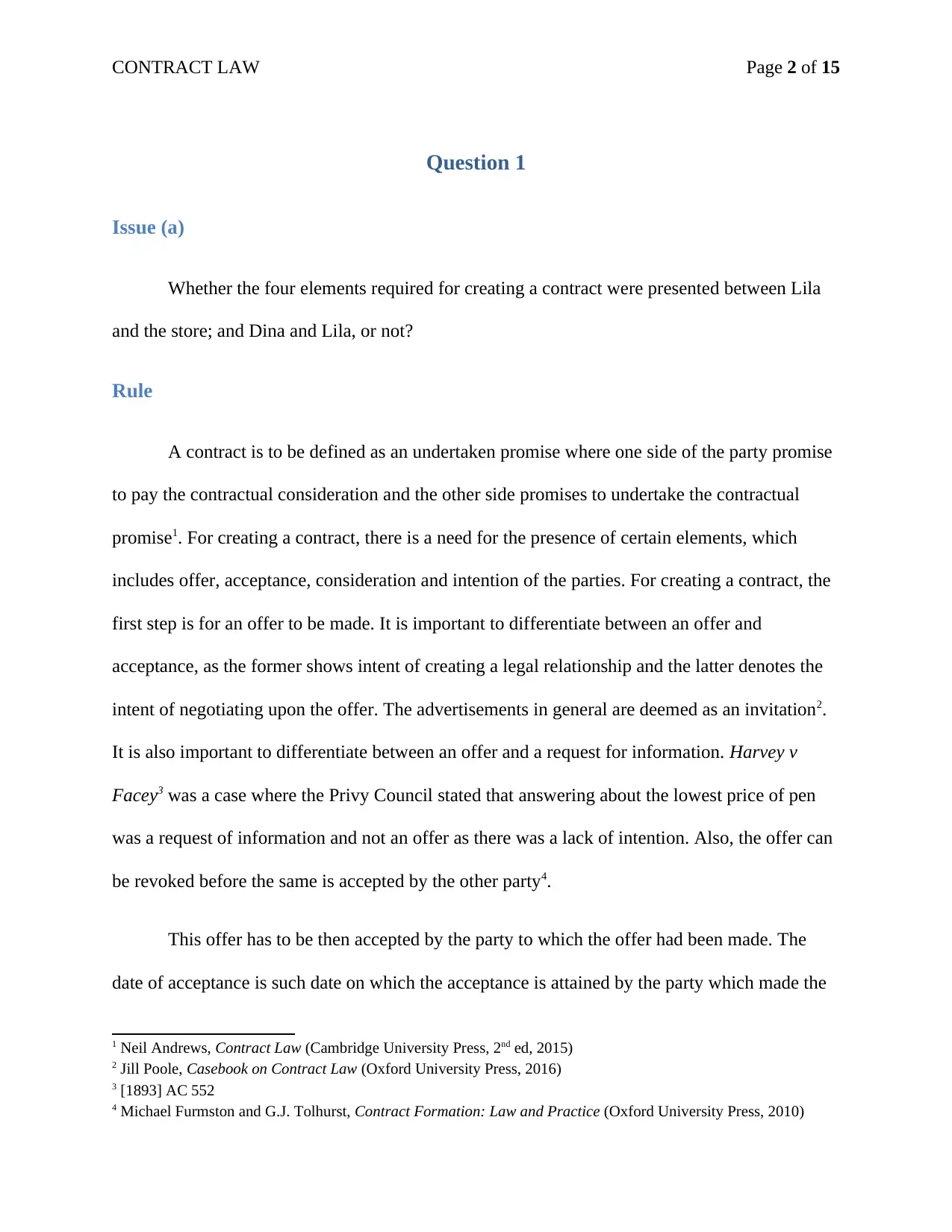
CONTRACT LAW Page 2 of 15
Question 1
Issue (a)
Whether the four elements required for creating a contract were presented between Lila
and the store; and Dina and Lila, or not?
Rule
A contract is to be defined as an undertaken promise where one side of the party promise
to pay the contractual consideration and the other side promises to undertake the contractual
promise1. For creating a contract, there is a need for the presence of certain elements, which
includes offer, acceptance, consideration and intention of the parties. For creating a contract, the
first step is for an offer to be made. It is important to differentiate between an offer and
acceptance, as the former shows intent of creating a legal relationship and the latter denotes the
intent of negotiating upon the offer. The advertisements in general are deemed as an invitation2.
It is also important to differentiate between an offer and a request for information. Harvey v
Facey3 was a case where the Privy Council stated that answering about the lowest price of pen
was a request of information and not an offer as there was a lack of intention. Also, the offer can
be revoked before the same is accepted by the other party4.
This offer has to be then accepted by the party to which the offer had been made. The
date of acceptance is such date on which the acceptance is attained by the party which made the
1 Neil Andrews, Contract Law (Cambridge University Press, 2nd ed, 2015)
2 Jill Poole, Casebook on Contract Law (Oxford University Press, 2016)
3 [1893] AC 552
4 Michael Furmston and G.J. Tolhurst, Contract Formation: Law and Practice (Oxford University Press, 2010)
Question 1
Issue (a)
Whether the four elements required for creating a contract were presented between Lila
and the store; and Dina and Lila, or not?
Rule
A contract is to be defined as an undertaken promise where one side of the party promise
to pay the contractual consideration and the other side promises to undertake the contractual
promise1. For creating a contract, there is a need for the presence of certain elements, which
includes offer, acceptance, consideration and intention of the parties. For creating a contract, the
first step is for an offer to be made. It is important to differentiate between an offer and
acceptance, as the former shows intent of creating a legal relationship and the latter denotes the
intent of negotiating upon the offer. The advertisements in general are deemed as an invitation2.
It is also important to differentiate between an offer and a request for information. Harvey v
Facey3 was a case where the Privy Council stated that answering about the lowest price of pen
was a request of information and not an offer as there was a lack of intention. Also, the offer can
be revoked before the same is accepted by the other party4.
This offer has to be then accepted by the party to which the offer had been made. The
date of acceptance is such date on which the acceptance is attained by the party which made the
1 Neil Andrews, Contract Law (Cambridge University Press, 2nd ed, 2015)
2 Jill Poole, Casebook on Contract Law (Oxford University Press, 2016)
3 [1893] AC 552
4 Michael Furmston and G.J. Tolhurst, Contract Formation: Law and Practice (Oxford University Press, 2010)
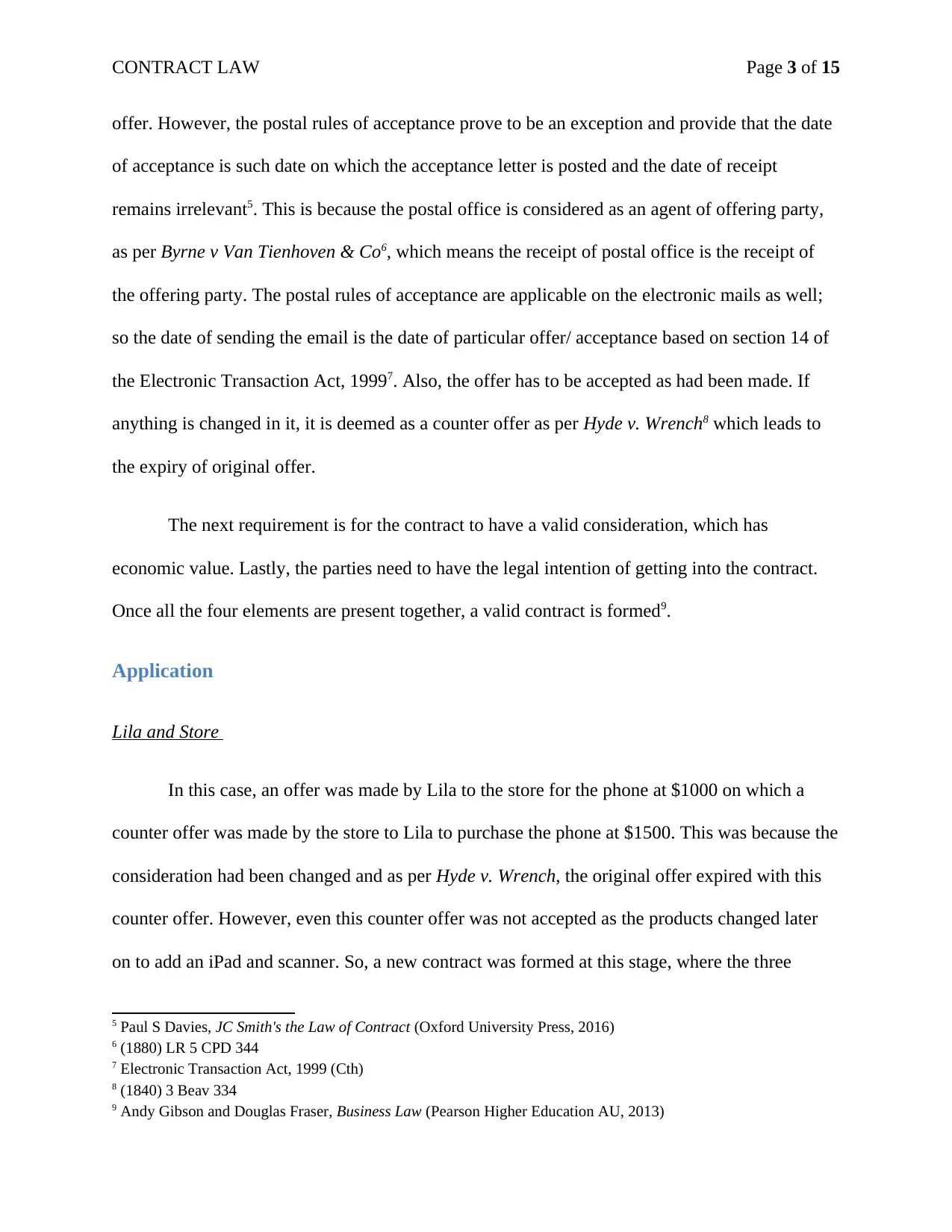
CONTRACT LAW Page 3 of 15
offer. However, the postal rules of acceptance prove to be an exception and provide that the date
of acceptance is such date on which the acceptance letter is posted and the date of receipt
remains irrelevant5. This is because the postal office is considered as an agent of offering party,
as per Byrne v Van Tienhoven & Co6, which means the receipt of postal office is the receipt of
the offering party. The postal rules of acceptance are applicable on the electronic mails as well;
so the date of sending the email is the date of particular offer/ acceptance based on section 14 of
the Electronic Transaction Act, 19997. Also, the offer has to be accepted as had been made. If
anything is changed in it, it is deemed as a counter offer as per Hyde v. Wrench8 which leads to
the expiry of original offer.
The next requirement is for the contract to have a valid consideration, which has
economic value. Lastly, the parties need to have the legal intention of getting into the contract.
Once all the four elements are present together, a valid contract is formed9.
Application
Lila and Store
In this case, an offer was made by Lila to the store for the phone at $1000 on which a
counter offer was made by the store to Lila to purchase the phone at $1500. This was because the
consideration had been changed and as per Hyde v. Wrench, the original offer expired with this
counter offer. However, even this counter offer was not accepted as the products changed later
on to add an iPad and scanner. So, a new contract was formed at this stage, where the three
5 Paul S Davies, JC Smith's the Law of Contract (Oxford University Press, 2016)
6 (1880) LR 5 CPD 344
7 Electronic Transaction Act, 1999 (Cth)
8 (1840) 3 Beav 334
9 Andy Gibson and Douglas Fraser, Business Law (Pearson Higher Education AU, 2013)
offer. However, the postal rules of acceptance prove to be an exception and provide that the date
of acceptance is such date on which the acceptance letter is posted and the date of receipt
remains irrelevant5. This is because the postal office is considered as an agent of offering party,
as per Byrne v Van Tienhoven & Co6, which means the receipt of postal office is the receipt of
the offering party. The postal rules of acceptance are applicable on the electronic mails as well;
so the date of sending the email is the date of particular offer/ acceptance based on section 14 of
the Electronic Transaction Act, 19997. Also, the offer has to be accepted as had been made. If
anything is changed in it, it is deemed as a counter offer as per Hyde v. Wrench8 which leads to
the expiry of original offer.
The next requirement is for the contract to have a valid consideration, which has
economic value. Lastly, the parties need to have the legal intention of getting into the contract.
Once all the four elements are present together, a valid contract is formed9.
Application
Lila and Store
In this case, an offer was made by Lila to the store for the phone at $1000 on which a
counter offer was made by the store to Lila to purchase the phone at $1500. This was because the
consideration had been changed and as per Hyde v. Wrench, the original offer expired with this
counter offer. However, even this counter offer was not accepted as the products changed later
on to add an iPad and scanner. So, a new contract was formed at this stage, where the three
5 Paul S Davies, JC Smith's the Law of Contract (Oxford University Press, 2016)
6 (1880) LR 5 CPD 344
7 Electronic Transaction Act, 1999 (Cth)
8 (1840) 3 Beav 334
9 Andy Gibson and Douglas Fraser, Business Law (Pearson Higher Education AU, 2013)
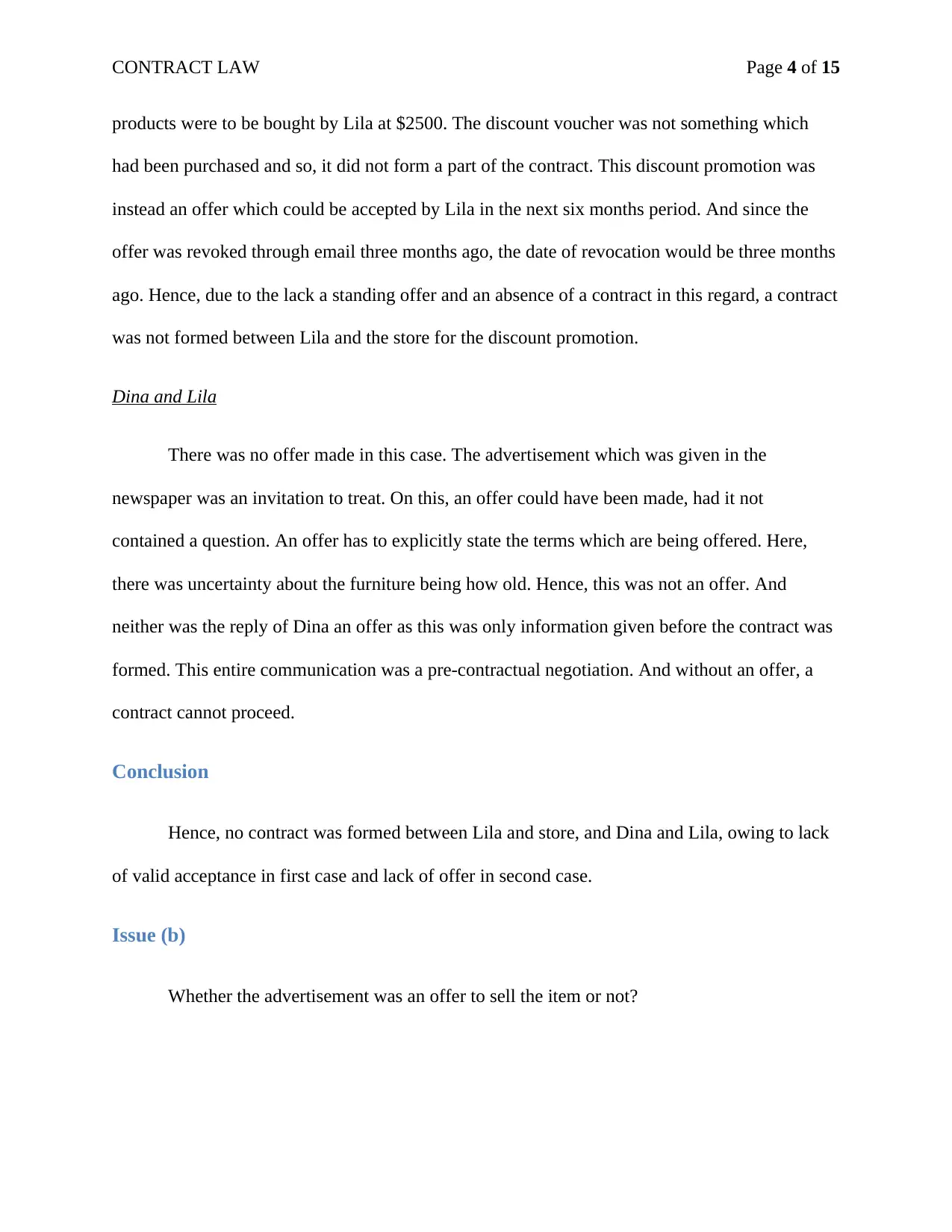
CONTRACT LAW Page 4 of 15
products were to be bought by Lila at $2500. The discount voucher was not something which
had been purchased and so, it did not form a part of the contract. This discount promotion was
instead an offer which could be accepted by Lila in the next six months period. And since the
offer was revoked through email three months ago, the date of revocation would be three months
ago. Hence, due to the lack a standing offer and an absence of a contract in this regard, a contract
was not formed between Lila and the store for the discount promotion.
Dina and Lila
There was no offer made in this case. The advertisement which was given in the
newspaper was an invitation to treat. On this, an offer could have been made, had it not
contained a question. An offer has to explicitly state the terms which are being offered. Here,
there was uncertainty about the furniture being how old. Hence, this was not an offer. And
neither was the reply of Dina an offer as this was only information given before the contract was
formed. This entire communication was a pre-contractual negotiation. And without an offer, a
contract cannot proceed.
Conclusion
Hence, no contract was formed between Lila and store, and Dina and Lila, owing to lack
of valid acceptance in first case and lack of offer in second case.
Issue (b)
Whether the advertisement was an offer to sell the item or not?
products were to be bought by Lila at $2500. The discount voucher was not something which
had been purchased and so, it did not form a part of the contract. This discount promotion was
instead an offer which could be accepted by Lila in the next six months period. And since the
offer was revoked through email three months ago, the date of revocation would be three months
ago. Hence, due to the lack a standing offer and an absence of a contract in this regard, a contract
was not formed between Lila and the store for the discount promotion.
Dina and Lila
There was no offer made in this case. The advertisement which was given in the
newspaper was an invitation to treat. On this, an offer could have been made, had it not
contained a question. An offer has to explicitly state the terms which are being offered. Here,
there was uncertainty about the furniture being how old. Hence, this was not an offer. And
neither was the reply of Dina an offer as this was only information given before the contract was
formed. This entire communication was a pre-contractual negotiation. And without an offer, a
contract cannot proceed.
Conclusion
Hence, no contract was formed between Lila and store, and Dina and Lila, owing to lack
of valid acceptance in first case and lack of offer in second case.
Issue (b)
Whether the advertisement was an offer to sell the item or not?
Secure Best Marks with AI Grader
Need help grading? Try our AI Grader for instant feedback on your assignments.
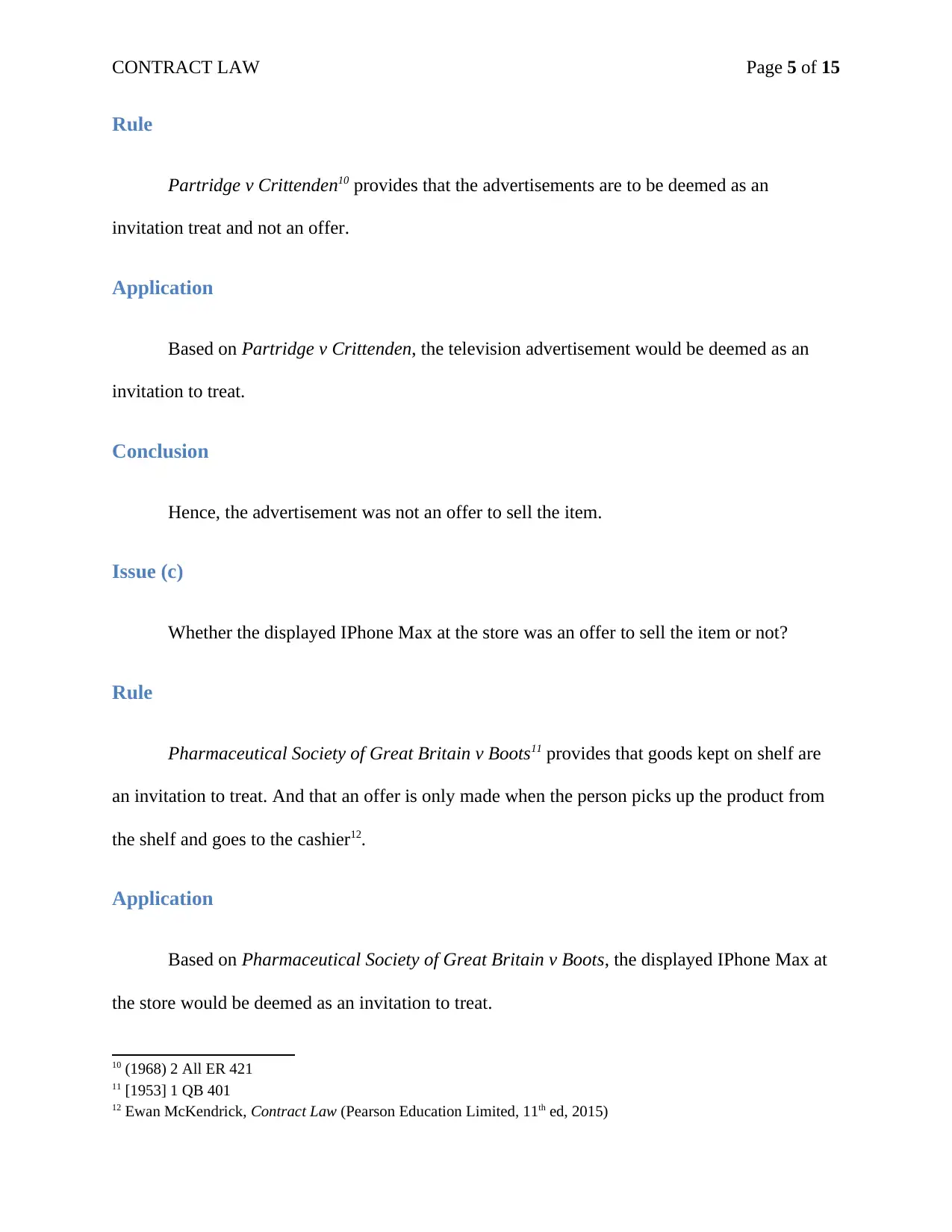
CONTRACT LAW Page 5 of 15
Rule
Partridge v Crittenden10 provides that the advertisements are to be deemed as an
invitation treat and not an offer.
Application
Based on Partridge v Crittenden, the television advertisement would be deemed as an
invitation to treat.
Conclusion
Hence, the advertisement was not an offer to sell the item.
Issue (c)
Whether the displayed IPhone Max at the store was an offer to sell the item or not?
Rule
Pharmaceutical Society of Great Britain v Boots11 provides that goods kept on shelf are
an invitation to treat. And that an offer is only made when the person picks up the product from
the shelf and goes to the cashier12.
Application
Based on Pharmaceutical Society of Great Britain v Boots, the displayed IPhone Max at
the store would be deemed as an invitation to treat.
10 (1968) 2 All ER 421
11 [1953] 1 QB 401
12 Ewan McKendrick, Contract Law (Pearson Education Limited, 11th ed, 2015)
Rule
Partridge v Crittenden10 provides that the advertisements are to be deemed as an
invitation treat and not an offer.
Application
Based on Partridge v Crittenden, the television advertisement would be deemed as an
invitation to treat.
Conclusion
Hence, the advertisement was not an offer to sell the item.
Issue (c)
Whether the displayed IPhone Max at the store was an offer to sell the item or not?
Rule
Pharmaceutical Society of Great Britain v Boots11 provides that goods kept on shelf are
an invitation to treat. And that an offer is only made when the person picks up the product from
the shelf and goes to the cashier12.
Application
Based on Pharmaceutical Society of Great Britain v Boots, the displayed IPhone Max at
the store would be deemed as an invitation to treat.
10 (1968) 2 All ER 421
11 [1953] 1 QB 401
12 Ewan McKendrick, Contract Law (Pearson Education Limited, 11th ed, 2015)
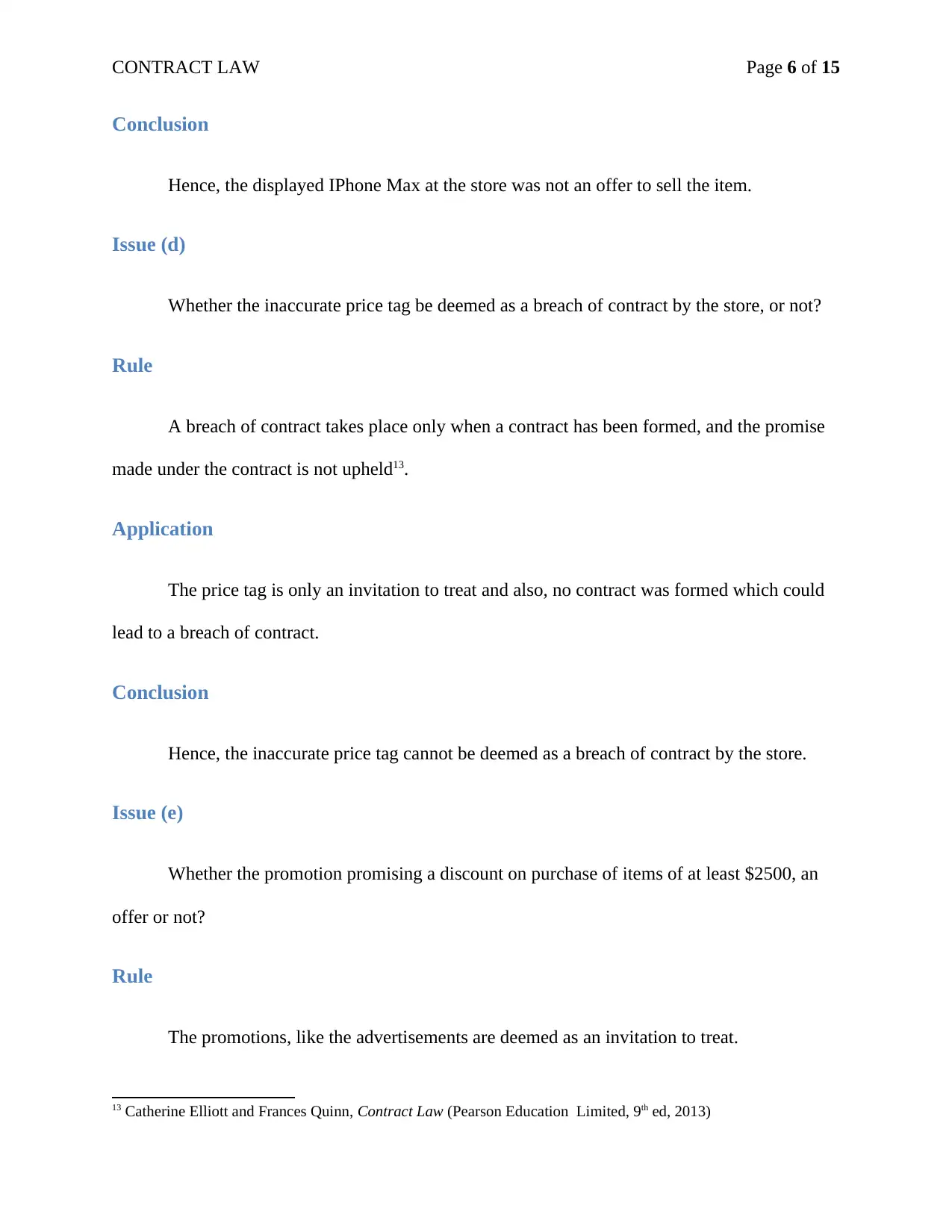
CONTRACT LAW Page 6 of 15
Conclusion
Hence, the displayed IPhone Max at the store was not an offer to sell the item.
Issue (d)
Whether the inaccurate price tag be deemed as a breach of contract by the store, or not?
Rule
A breach of contract takes place only when a contract has been formed, and the promise
made under the contract is not upheld13.
Application
The price tag is only an invitation to treat and also, no contract was formed which could
lead to a breach of contract.
Conclusion
Hence, the inaccurate price tag cannot be deemed as a breach of contract by the store.
Issue (e)
Whether the promotion promising a discount on purchase of items of at least $2500, an
offer or not?
Rule
The promotions, like the advertisements are deemed as an invitation to treat.
13 Catherine Elliott and Frances Quinn, Contract Law (Pearson Education Limited, 9th ed, 2013)
Conclusion
Hence, the displayed IPhone Max at the store was not an offer to sell the item.
Issue (d)
Whether the inaccurate price tag be deemed as a breach of contract by the store, or not?
Rule
A breach of contract takes place only when a contract has been formed, and the promise
made under the contract is not upheld13.
Application
The price tag is only an invitation to treat and also, no contract was formed which could
lead to a breach of contract.
Conclusion
Hence, the inaccurate price tag cannot be deemed as a breach of contract by the store.
Issue (e)
Whether the promotion promising a discount on purchase of items of at least $2500, an
offer or not?
Rule
The promotions, like the advertisements are deemed as an invitation to treat.
13 Catherine Elliott and Frances Quinn, Contract Law (Pearson Education Limited, 9th ed, 2013)
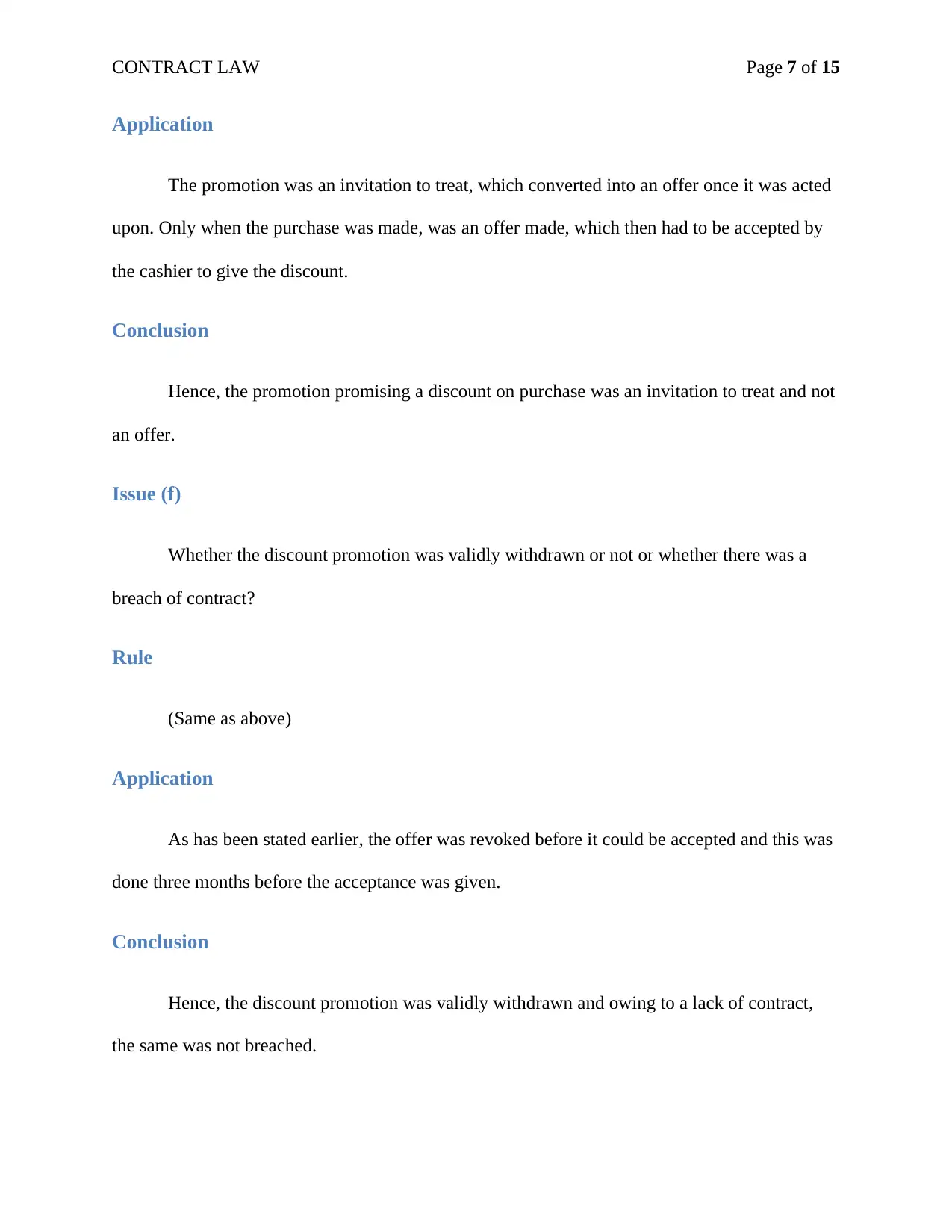
CONTRACT LAW Page 7 of 15
Application
The promotion was an invitation to treat, which converted into an offer once it was acted
upon. Only when the purchase was made, was an offer made, which then had to be accepted by
the cashier to give the discount.
Conclusion
Hence, the promotion promising a discount on purchase was an invitation to treat and not
an offer.
Issue (f)
Whether the discount promotion was validly withdrawn or not or whether there was a
breach of contract?
Rule
(Same as above)
Application
As has been stated earlier, the offer was revoked before it could be accepted and this was
done three months before the acceptance was given.
Conclusion
Hence, the discount promotion was validly withdrawn and owing to a lack of contract,
the same was not breached.
Application
The promotion was an invitation to treat, which converted into an offer once it was acted
upon. Only when the purchase was made, was an offer made, which then had to be accepted by
the cashier to give the discount.
Conclusion
Hence, the promotion promising a discount on purchase was an invitation to treat and not
an offer.
Issue (f)
Whether the discount promotion was validly withdrawn or not or whether there was a
breach of contract?
Rule
(Same as above)
Application
As has been stated earlier, the offer was revoked before it could be accepted and this was
done three months before the acceptance was given.
Conclusion
Hence, the discount promotion was validly withdrawn and owing to a lack of contract,
the same was not breached.
Paraphrase This Document
Need a fresh take? Get an instant paraphrase of this document with our AI Paraphraser
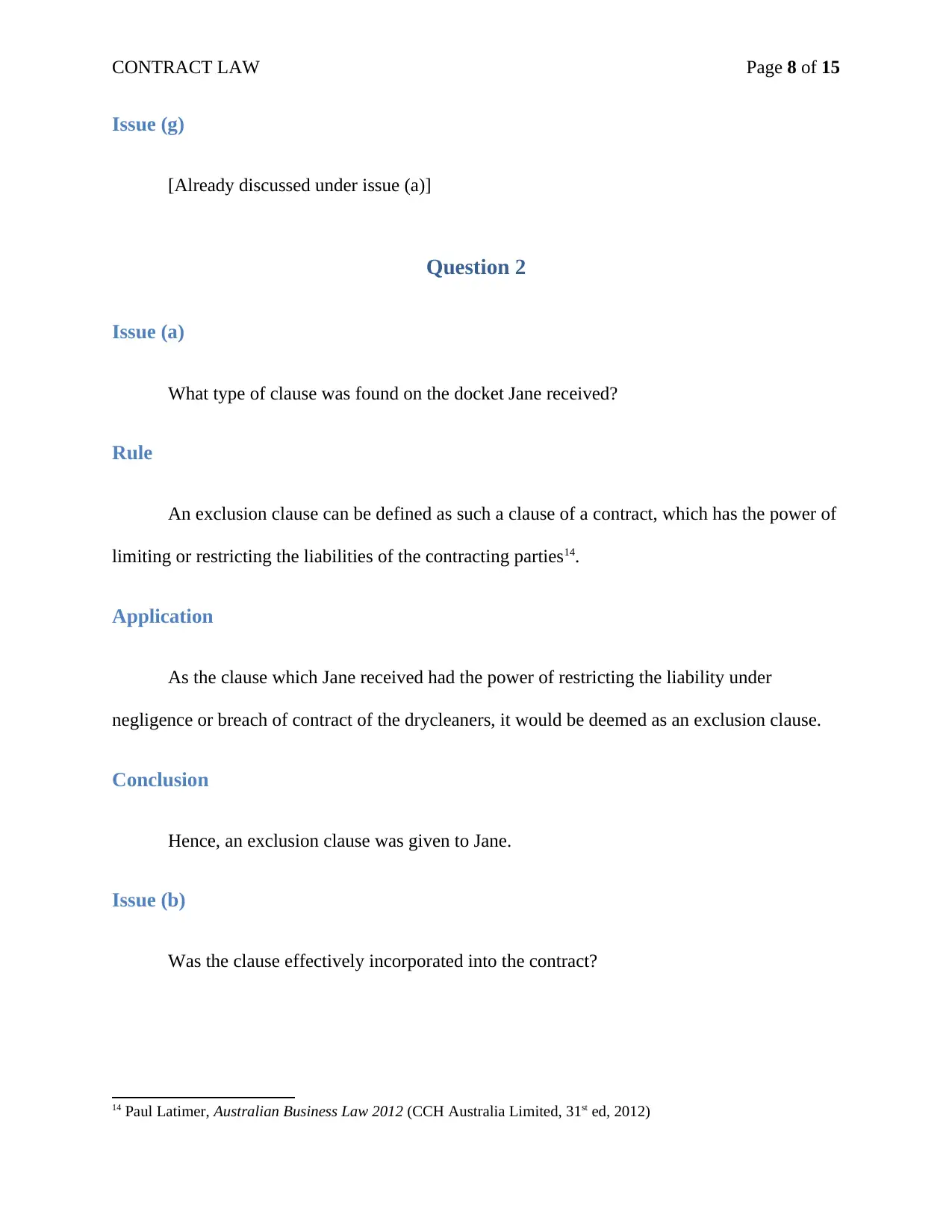
CONTRACT LAW Page 8 of 15
Issue (g)
[Already discussed under issue (a)]
Question 2
Issue (a)
What type of clause was found on the docket Jane received?
Rule
An exclusion clause can be defined as such a clause of a contract, which has the power of
limiting or restricting the liabilities of the contracting parties14.
Application
As the clause which Jane received had the power of restricting the liability under
negligence or breach of contract of the drycleaners, it would be deemed as an exclusion clause.
Conclusion
Hence, an exclusion clause was given to Jane.
Issue (b)
Was the clause effectively incorporated into the contract?
14 Paul Latimer, Australian Business Law 2012 (CCH Australia Limited, 31st ed, 2012)
Issue (g)
[Already discussed under issue (a)]
Question 2
Issue (a)
What type of clause was found on the docket Jane received?
Rule
An exclusion clause can be defined as such a clause of a contract, which has the power of
limiting or restricting the liabilities of the contracting parties14.
Application
As the clause which Jane received had the power of restricting the liability under
negligence or breach of contract of the drycleaners, it would be deemed as an exclusion clause.
Conclusion
Hence, an exclusion clause was given to Jane.
Issue (b)
Was the clause effectively incorporated into the contract?
14 Paul Latimer, Australian Business Law 2012 (CCH Australia Limited, 31st ed, 2012)
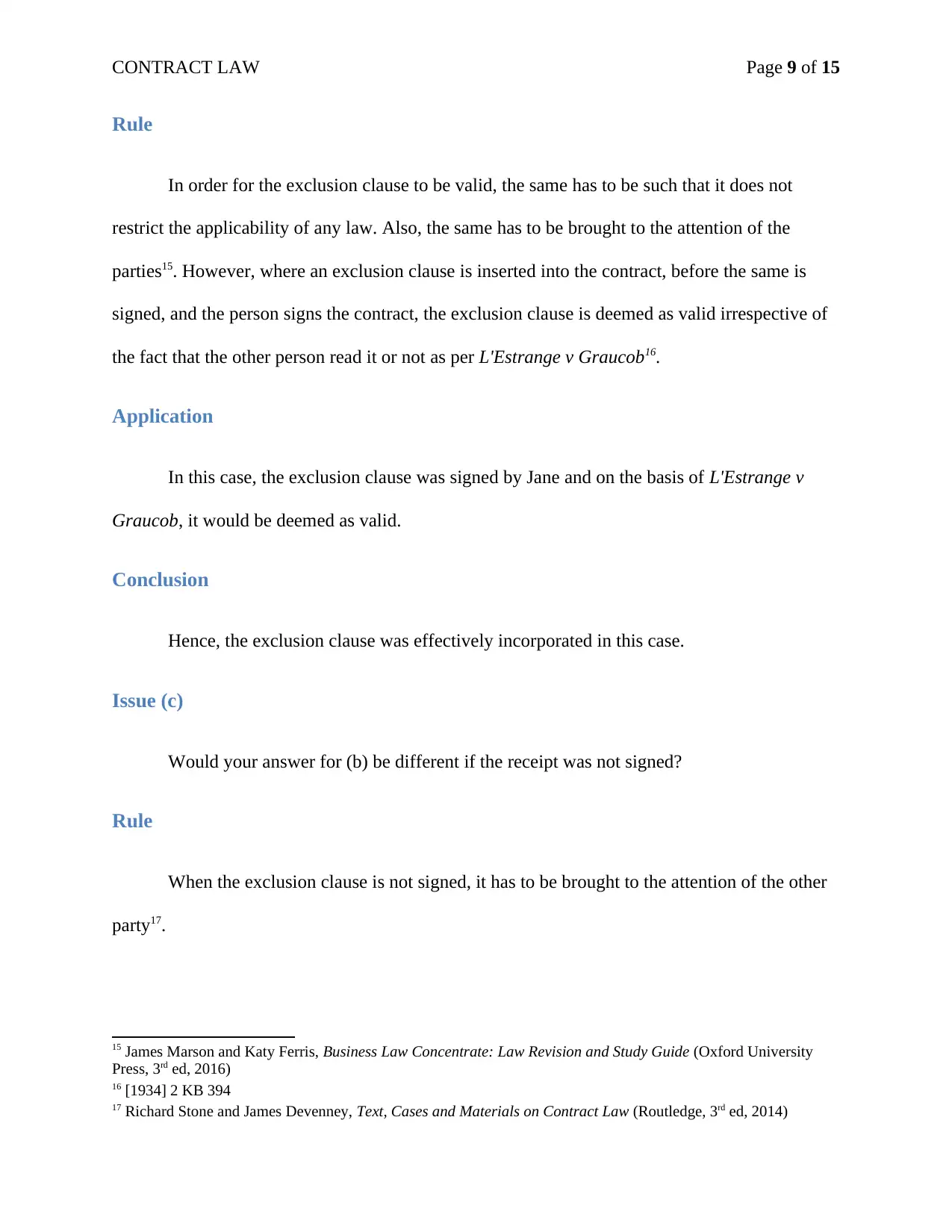
CONTRACT LAW Page 9 of 15
Rule
In order for the exclusion clause to be valid, the same has to be such that it does not
restrict the applicability of any law. Also, the same has to be brought to the attention of the
parties15. However, where an exclusion clause is inserted into the contract, before the same is
signed, and the person signs the contract, the exclusion clause is deemed as valid irrespective of
the fact that the other person read it or not as per L'Estrange v Graucob16.
Application
In this case, the exclusion clause was signed by Jane and on the basis of L'Estrange v
Graucob, it would be deemed as valid.
Conclusion
Hence, the exclusion clause was effectively incorporated in this case.
Issue (c)
Would your answer for (b) be different if the receipt was not signed?
Rule
When the exclusion clause is not signed, it has to be brought to the attention of the other
party17.
15 James Marson and Katy Ferris, Business Law Concentrate: Law Revision and Study Guide (Oxford University
Press, 3rd ed, 2016)
16 [1934] 2 KB 394
17 Richard Stone and James Devenney, Text, Cases and Materials on Contract Law (Routledge, 3rd ed, 2014)
Rule
In order for the exclusion clause to be valid, the same has to be such that it does not
restrict the applicability of any law. Also, the same has to be brought to the attention of the
parties15. However, where an exclusion clause is inserted into the contract, before the same is
signed, and the person signs the contract, the exclusion clause is deemed as valid irrespective of
the fact that the other person read it or not as per L'Estrange v Graucob16.
Application
In this case, the exclusion clause was signed by Jane and on the basis of L'Estrange v
Graucob, it would be deemed as valid.
Conclusion
Hence, the exclusion clause was effectively incorporated in this case.
Issue (c)
Would your answer for (b) be different if the receipt was not signed?
Rule
When the exclusion clause is not signed, it has to be brought to the attention of the other
party17.
15 James Marson and Katy Ferris, Business Law Concentrate: Law Revision and Study Guide (Oxford University
Press, 3rd ed, 2016)
16 [1934] 2 KB 394
17 Richard Stone and James Devenney, Text, Cases and Materials on Contract Law (Routledge, 3rd ed, 2014)
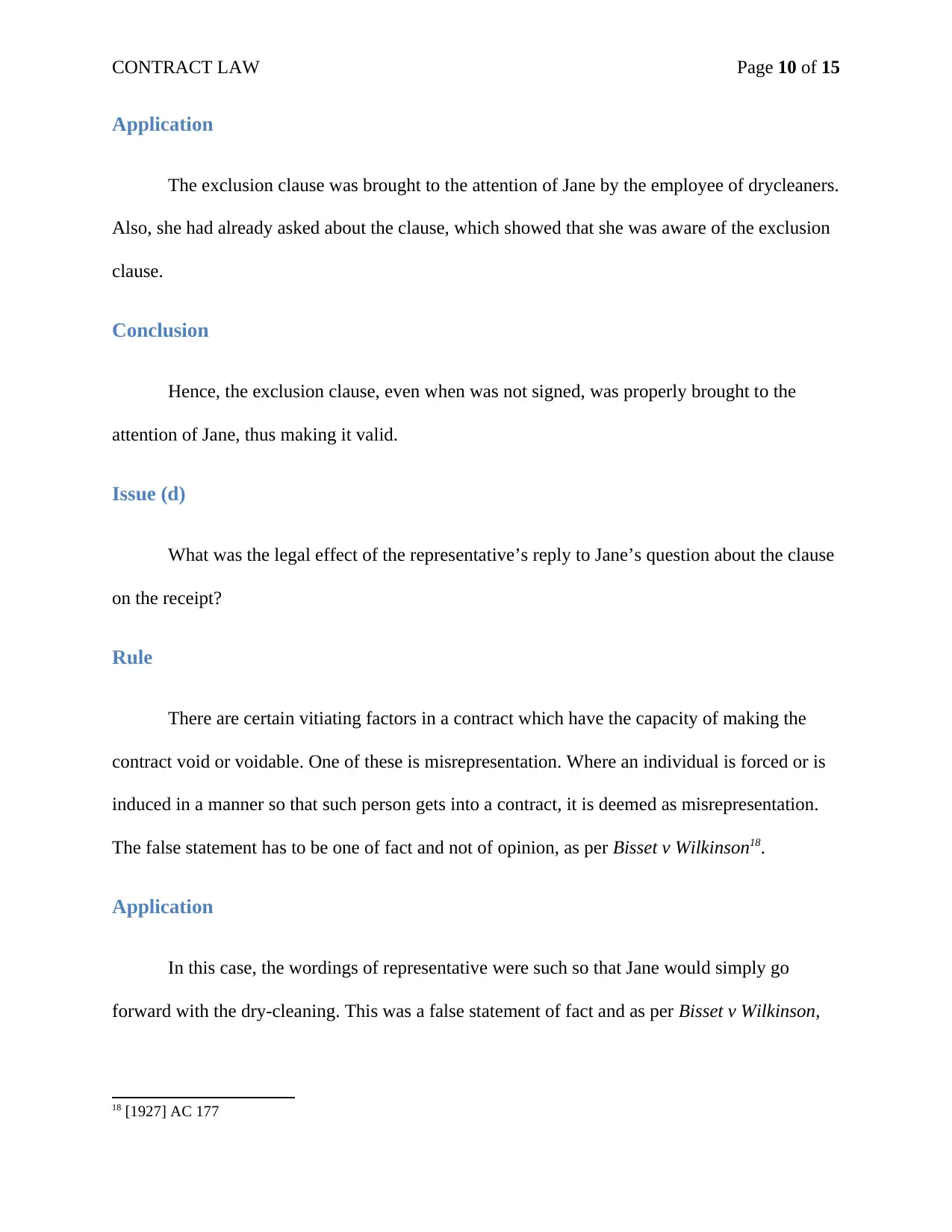
CONTRACT LAW Page 10 of 15
Application
The exclusion clause was brought to the attention of Jane by the employee of drycleaners.
Also, she had already asked about the clause, which showed that she was aware of the exclusion
clause.
Conclusion
Hence, the exclusion clause, even when was not signed, was properly brought to the
attention of Jane, thus making it valid.
Issue (d)
What was the legal effect of the representative’s reply to Jane’s question about the clause
on the receipt?
Rule
There are certain vitiating factors in a contract which have the capacity of making the
contract void or voidable. One of these is misrepresentation. Where an individual is forced or is
induced in a manner so that such person gets into a contract, it is deemed as misrepresentation.
The false statement has to be one of fact and not of opinion, as per Bisset v Wilkinson18.
Application
In this case, the wordings of representative were such so that Jane would simply go
forward with the dry-cleaning. This was a false statement of fact and as per Bisset v Wilkinson,
18 [1927] AC 177
Application
The exclusion clause was brought to the attention of Jane by the employee of drycleaners.
Also, she had already asked about the clause, which showed that she was aware of the exclusion
clause.
Conclusion
Hence, the exclusion clause, even when was not signed, was properly brought to the
attention of Jane, thus making it valid.
Issue (d)
What was the legal effect of the representative’s reply to Jane’s question about the clause
on the receipt?
Rule
There are certain vitiating factors in a contract which have the capacity of making the
contract void or voidable. One of these is misrepresentation. Where an individual is forced or is
induced in a manner so that such person gets into a contract, it is deemed as misrepresentation.
The false statement has to be one of fact and not of opinion, as per Bisset v Wilkinson18.
Application
In this case, the wordings of representative were such so that Jane would simply go
forward with the dry-cleaning. This was a false statement of fact and as per Bisset v Wilkinson,
18 [1927] AC 177
Secure Best Marks with AI Grader
Need help grading? Try our AI Grader for instant feedback on your assignments.

CONTRACT LAW Page 11 of 15
this would be deemed as misrepresentation. His reply misrepresented that the clause meant that it
was nothing when it avoided the liability of the drycleaners from damage to the cloth.
Conclusion
Hence, the representative’s reply was misrepresentation.
Issue (e)
Was the wording of the clause clear?
Rule
The exclusion clause, for being valid, has to be such that it is clear and not ambiguous.
Application
The wordings of the exclusion clause were very clear and easily comprehensible.
Conclusion
Hence, the wordings of the clause were clear.
Issue (f)
Is the four corners rule relevant here?
Rule
As per the four corners rule, the written contract has to be interpreted solely as per its
textual context.
this would be deemed as misrepresentation. His reply misrepresented that the clause meant that it
was nothing when it avoided the liability of the drycleaners from damage to the cloth.
Conclusion
Hence, the representative’s reply was misrepresentation.
Issue (e)
Was the wording of the clause clear?
Rule
The exclusion clause, for being valid, has to be such that it is clear and not ambiguous.
Application
The wordings of the exclusion clause were very clear and easily comprehensible.
Conclusion
Hence, the wordings of the clause were clear.
Issue (f)
Is the four corners rule relevant here?
Rule
As per the four corners rule, the written contract has to be interpreted solely as per its
textual context.

CONTRACT LAW Page 12 of 15
Application
In this case, the four corner rule cannot be applied owing to misrepresentation of the
employee of the drycleaners.
Conclusion
Hence, the four corners rule is not relevant here.
Issue (g)
Overall, are you of the opinion that Jane can claim for her damaged gown?
Rule
Curtis v Chemical Cleaning and Dyeing Co19 was a case where the court held that even
when the exclusion clause is properly inserted into the contract and is signed by the parties, an
exception to L'Estrange v Graucob would be made, when there is an element of
misrepresentation included in such transaction. The facts of this case are similar to the given case
study also. So the ruling of this has to be applied here.
Application
In the given case study, it has already been established that the exclusion clause was even
though signed, but covered the misrepresentation of the employee of the drycleaners. So, because
of the misrepresentation of the effects of the exclusion clause, reliance cannot be made on the
exclusion clause, despite it being signed. And based on Curtis v Chemical Cleaning and Dyeing
19 [1951] 1 KB 805
Application
In this case, the four corner rule cannot be applied owing to misrepresentation of the
employee of the drycleaners.
Conclusion
Hence, the four corners rule is not relevant here.
Issue (g)
Overall, are you of the opinion that Jane can claim for her damaged gown?
Rule
Curtis v Chemical Cleaning and Dyeing Co19 was a case where the court held that even
when the exclusion clause is properly inserted into the contract and is signed by the parties, an
exception to L'Estrange v Graucob would be made, when there is an element of
misrepresentation included in such transaction. The facts of this case are similar to the given case
study also. So the ruling of this has to be applied here.
Application
In the given case study, it has already been established that the exclusion clause was even
though signed, but covered the misrepresentation of the employee of the drycleaners. So, because
of the misrepresentation of the effects of the exclusion clause, reliance cannot be made on the
exclusion clause, despite it being signed. And based on Curtis v Chemical Cleaning and Dyeing
19 [1951] 1 KB 805
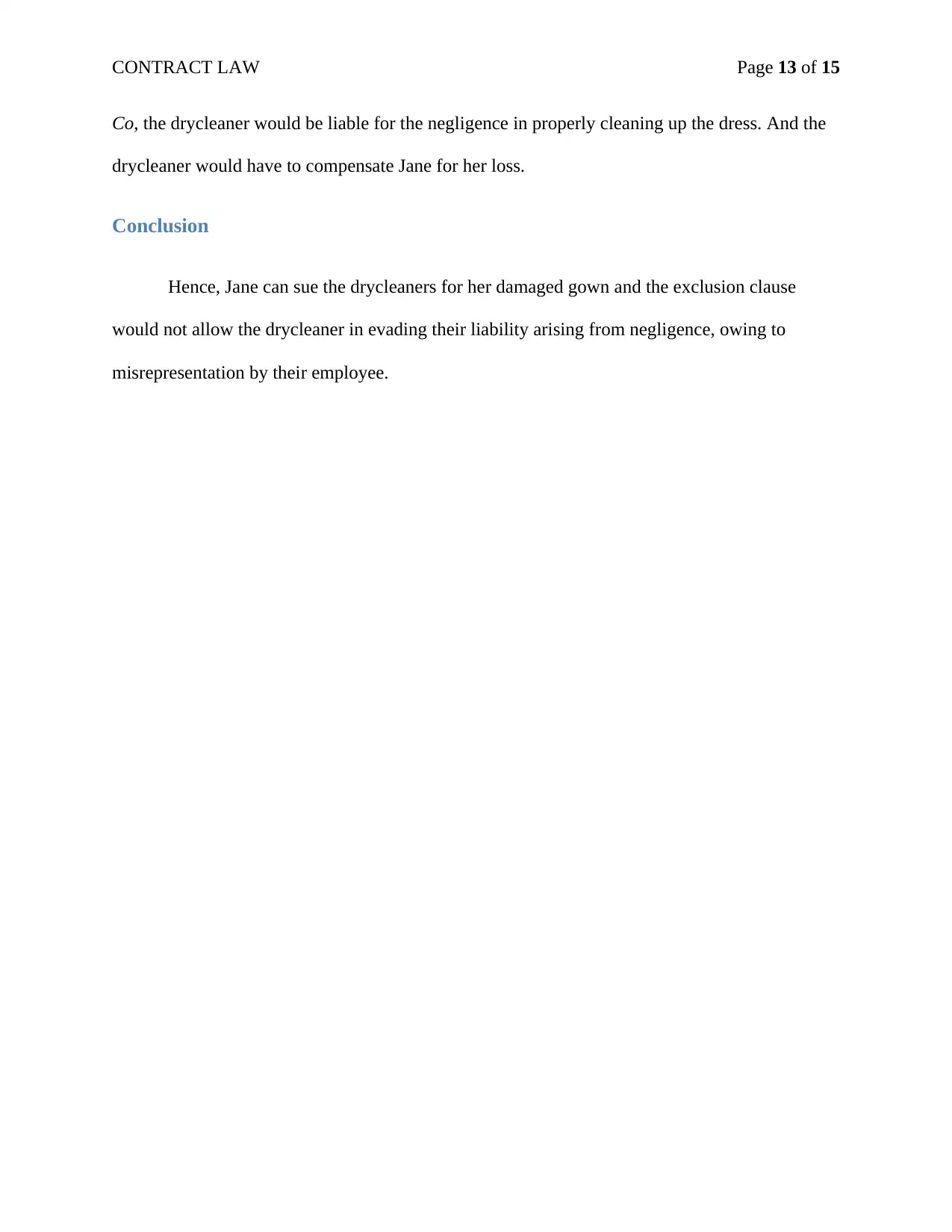
CONTRACT LAW Page 13 of 15
Co, the drycleaner would be liable for the negligence in properly cleaning up the dress. And the
drycleaner would have to compensate Jane for her loss.
Conclusion
Hence, Jane can sue the drycleaners for her damaged gown and the exclusion clause
would not allow the drycleaner in evading their liability arising from negligence, owing to
misrepresentation by their employee.
Co, the drycleaner would be liable for the negligence in properly cleaning up the dress. And the
drycleaner would have to compensate Jane for her loss.
Conclusion
Hence, Jane can sue the drycleaners for her damaged gown and the exclusion clause
would not allow the drycleaner in evading their liability arising from negligence, owing to
misrepresentation by their employee.
Paraphrase This Document
Need a fresh take? Get an instant paraphrase of this document with our AI Paraphraser
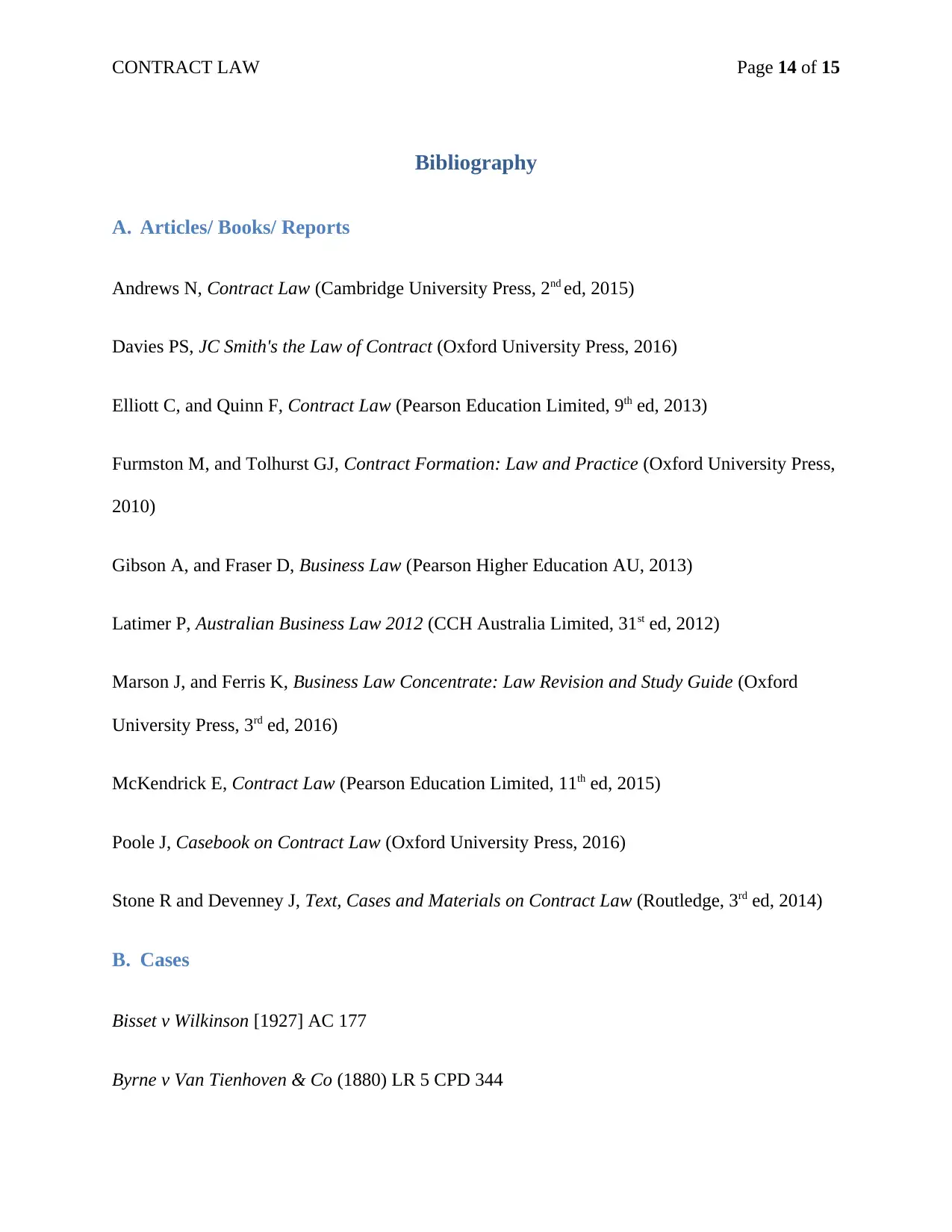
CONTRACT LAW Page 14 of 15
Bibliography
A. Articles/ Books/ Reports
Andrews N, Contract Law (Cambridge University Press, 2nd ed, 2015)
Davies PS, JC Smith's the Law of Contract (Oxford University Press, 2016)
Elliott C, and Quinn F, Contract Law (Pearson Education Limited, 9th ed, 2013)
Furmston M, and Tolhurst GJ, Contract Formation: Law and Practice (Oxford University Press,
2010)
Gibson A, and Fraser D, Business Law (Pearson Higher Education AU, 2013)
Latimer P, Australian Business Law 2012 (CCH Australia Limited, 31st ed, 2012)
Marson J, and Ferris K, Business Law Concentrate: Law Revision and Study Guide (Oxford
University Press, 3rd ed, 2016)
McKendrick E, Contract Law (Pearson Education Limited, 11th ed, 2015)
Poole J, Casebook on Contract Law (Oxford University Press, 2016)
Stone R and Devenney J, Text, Cases and Materials on Contract Law (Routledge, 3rd ed, 2014)
B. Cases
Bisset v Wilkinson [1927] AC 177
Byrne v Van Tienhoven & Co (1880) LR 5 CPD 344
Bibliography
A. Articles/ Books/ Reports
Andrews N, Contract Law (Cambridge University Press, 2nd ed, 2015)
Davies PS, JC Smith's the Law of Contract (Oxford University Press, 2016)
Elliott C, and Quinn F, Contract Law (Pearson Education Limited, 9th ed, 2013)
Furmston M, and Tolhurst GJ, Contract Formation: Law and Practice (Oxford University Press,
2010)
Gibson A, and Fraser D, Business Law (Pearson Higher Education AU, 2013)
Latimer P, Australian Business Law 2012 (CCH Australia Limited, 31st ed, 2012)
Marson J, and Ferris K, Business Law Concentrate: Law Revision and Study Guide (Oxford
University Press, 3rd ed, 2016)
McKendrick E, Contract Law (Pearson Education Limited, 11th ed, 2015)
Poole J, Casebook on Contract Law (Oxford University Press, 2016)
Stone R and Devenney J, Text, Cases and Materials on Contract Law (Routledge, 3rd ed, 2014)
B. Cases
Bisset v Wilkinson [1927] AC 177
Byrne v Van Tienhoven & Co (1880) LR 5 CPD 344
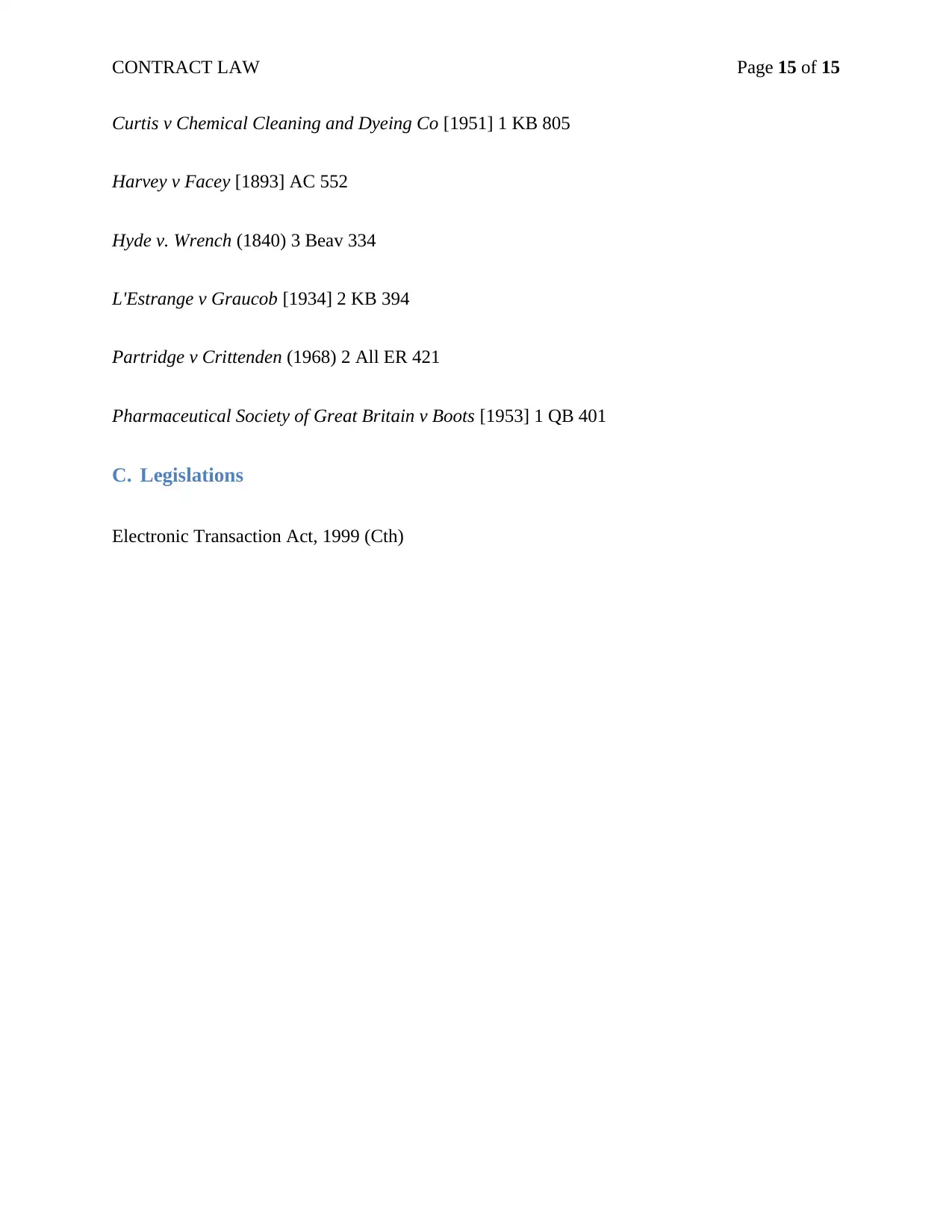
CONTRACT LAW Page 15 of 15
Curtis v Chemical Cleaning and Dyeing Co [1951] 1 KB 805
Harvey v Facey [1893] AC 552
Hyde v. Wrench (1840) 3 Beav 334
L'Estrange v Graucob [1934] 2 KB 394
Partridge v Crittenden (1968) 2 All ER 421
Pharmaceutical Society of Great Britain v Boots [1953] 1 QB 401
C. Legislations
Electronic Transaction Act, 1999 (Cth)
Curtis v Chemical Cleaning and Dyeing Co [1951] 1 KB 805
Harvey v Facey [1893] AC 552
Hyde v. Wrench (1840) 3 Beav 334
L'Estrange v Graucob [1934] 2 KB 394
Partridge v Crittenden (1968) 2 All ER 421
Pharmaceutical Society of Great Britain v Boots [1953] 1 QB 401
C. Legislations
Electronic Transaction Act, 1999 (Cth)
1 out of 15
Related Documents
Your All-in-One AI-Powered Toolkit for Academic Success.
+13062052269
info@desklib.com
Available 24*7 on WhatsApp / Email
![[object Object]](/_next/static/media/star-bottom.7253800d.svg)
Unlock your academic potential
© 2024 | Zucol Services PVT LTD | All rights reserved.





